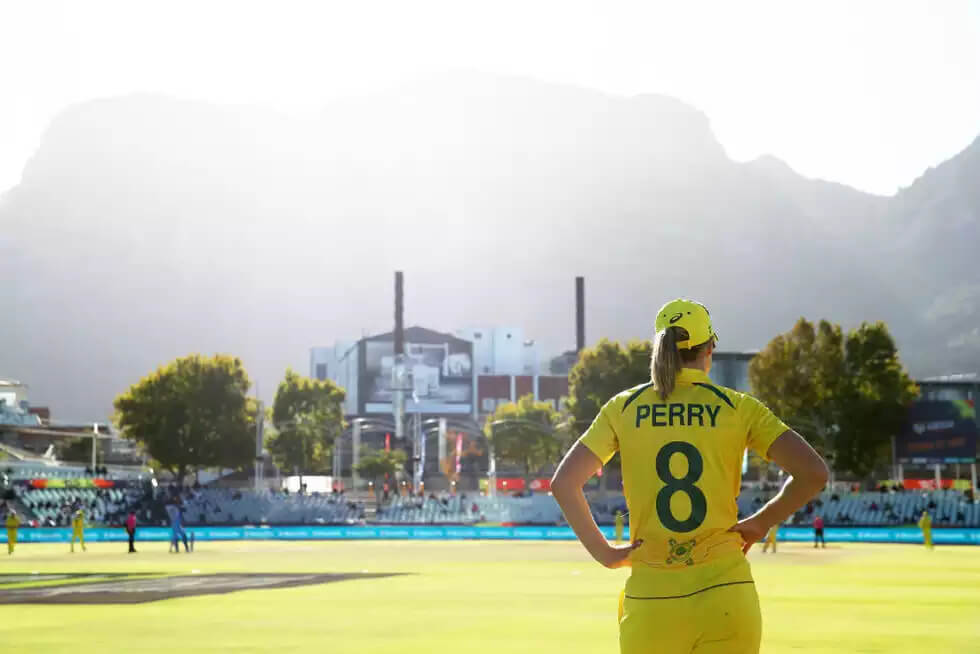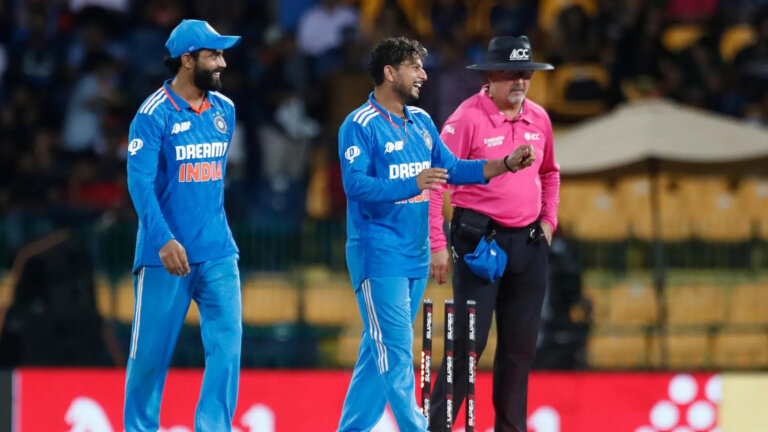
Tazmin Brits’ right arm has accomplished plenty in her sporting career. An ability to propel a javelin substantial distances almost took her to the Olympics, but her most important contribution to South African sport to date came on Friday night at Newlands.
As much as Brits sees her innings of 68 off 55 balls as the more important line on the scorecard in South Africa’s victory, her four catches in the field were just as vital. Few moments in the game’s highlight reel stand out as much as one stunning piece of athleticism in the sixth over.
Shabnim Ismail fired down one of her favoured bouncers. Facing just her second delivery, Alice Capsey responded with a mistimed pull shot, more out of surprise than anything else. The ball looped into the leg side where Brits dove to her right, stuck out that right arm and snaffled the chance with a one-handed catch.
With the ball safely lodged in her palm, that right arm, branded with an Olympic rings tattoo in a nod to Brits’ javelin days, flung the white ball high into the Cape Town sky. Such was the euphoria and disbelief, Brits wasn’t sure how she pulled it off herself.
“I was actually hoping you’re going to tell me what happened,” she joked. “I also don’t know what happened there, my legs were so tired after the batting. I just reacted and yeah, it stuck.”
Just under 24 hours earlier, this World Cup’s other semi-final saw a mistake as its defining moment. Harmanpreet Kaur’s bat lodging itself in the ground will live long in India’s memory, but if searching for a positive moment of individual brilliance to reflect the contest, look no further than Ellyse Perry’s ground fielding.
In the 19th over, with India looking to recover after the departure of Harmanpreet and Richa Ghosh, Perry showed off her own athleticism on the boundary at deep backward square. Her dive saved two runs then, significant given the margin of victory was just five, but her efforts on the rope throughout the contest proved vital.
“I think we showed our class today in the field and we always speak about as a group being the best fielding team in the world,” reflected Thursday’s player of the match Ashleigh Gardner. “Today really showed that Ellyse Perry is elite on the boundary, she probably saved six runs herself.
“I think we took those pivotal moments when we really needed to… At the end of the day, that could have been something that I guess was the difference between us and them [India].”
In a tournament all too often characterised by poor fielding across the board, the two sides whose work in the outfield held up at critical moments meet in Sunday’s final.
In some cases, resources and infrastructure go some way to explaining the litany of errors witnessed over the last fortnight. Ireland, one of this World Cup’s biggest culprits when it came to dropped chances, can’t train properly during their cold, wet winter given a lack of outdoor facilities. Good luck hitting high catches indoors.
Such facility issues don’t plague the majority of the other teams at this tournament. Gardner revealed Australia’s pride in being the best fielding team in the world, but every outfit must set themselves similar, lofty goals. Conventional wisdom dictates that fielding is the one area of the game where talent gaps can be overcome by hard work.
As Harmanpreet outlined after India’s loss, Australia “always field well.” How do they stay ahead of the chasing pack?
“Well, first of all, we have KPIs [key performance indicators] and they’re markers that show us whether we’re positive or negative in the field,” explains Gardner. “If we know that we’ve fielded badly, we could be minus 10. But if we’ve fielded really well, we’re plus six.
“So there’s a pretty clear indication how we’ve fielded. Obviously it is subjective, but I think we just know how to push each other.”
Australia plug resources into specific metrics for fielding analysis. As one journalist at the first semi-final scoffed: “Of course they do, they have the money for it.”
Being well-resourced has almost become a stick with which to beat this dynastic Australia side. Such a jealousy-tinged repost aside, further prying into the nature of these magic metrics reveals, lo and behold, it’s all actually quite simple.
“We record catches taken and what grade catch they are, whether it’s an easy one or more difficult or a really tough one,” explains Shelley Nitschke, Australia’s head coach. “We have a marking system that we set up and make sure we get a score every game. We take a look at the other team and how they do, if we potentially outfield them.
“That’s pretty simple. That’s something that, when we’re watching the game, we just record it as we see it. Usually the analyst will grade the catches and the bowling coach will take care of the ground ball stuff.
“It’s not an extensive science. It just gives us something to come back to every time, it’s pretty consistent. We’ve had them for a little while, as long as I’ve been involved in the team so at least four years. We just keep tweaking and evolving them over time so they’re still current and we’re still pushing the girls hard enough.”
Virtually all international teams have an analyst and a bowling coach; India even had two throwdown specialists in their camp for this tournament. The information at play here is also readily available. It’s hardly rocket science or resource-intensive. Still, useful benchmarks are set.
Combine such high standards with the second facet of fielding that separates Australia and that’s when the conversation around professionalism and resources becomes more relevant.
“I think our athletic ability is also one of the things that we’re probably at the higher end of nations around the world,” explained Gardner. “And that’s something that we really pride ourselves on is being fit, being strong. That’s one of the things that has an impact in the field.
“We all push each other, whether it’s on the field or off the field, whether it’s in the gym or running.”
Again, Nitschke explains further: “When we talk about athleticism we’re talking about agility, ability to cut angles in the field, ability to get out of the crease when batting, ability to play the game of cricket. The physical requirements of the game.
“Athletically we’re really good so it’s about how we can make our athleticism count in the game, not just with fielding, but with running between the wickets as well. Being athletic, how can we leverage that to win a game of cricket?”
The obvious answer is by saving runs at crucial junctures a la Perry, or holding onto catches Brits-style that other, less athletic players wouldn’t have got a hand on, even to earn the right to drop.
The mere mention of South Africa’s Brits proves that Australia don’t have a monopoly on athleticism. But being professional athletes for as long as they have with proper investment in agility work can’t but create an Australian point of difference when compared to sides that don’t have those same luxuries.
Sporting culture also plays a role. Multi-sport backgrounds produce diverse athletic profiles, with Brits and Perry – who also played soccer for Australia – continuing to stand out as examples.
“At a young age we still encourage them to play other sports,” confirms Nitschke. “Darcie Brown is a classic example, she’s played a lot of netball and other sports growing up. It’s good for them socially as well.”
If rigorous analysis and quality athleticism are the key pillars of good fielding, there is still one uncontrollable factor: pressure.
England are by no means unathletic mugs with low standards, but at times their work let them down on Friday. “Sometimes it’s really hard to explain fielding,” lamented Heather Knight. “And obviously it was very loud out there.”
Referring to the Newlands crowd – 7,547 on a working afternoon, more will be expected for Sunday’s final – Knight offered a glimpse into the pressure-cooker that can undo all the well-resourced hard work in the world.
How to mitigate against that? Gardner spoke about creating pressurised situations in training, but nothing beats the real thing. Since 2010, Australia have reached nine out of a possible 10 World Cup finals across both formats, winning seven of those. Few can match their ability to execute amidst the greatest jeopardy.
Add in a solid, albeit simple, resource-friendly analytics system and an ability to develop the best athletes, a self-perpetuating narrative emerges. The more Australia control the fielding controllables smarter than most, the more they become better than everyone else at dealing with variables like pressure, simply by experiencing and thriving in it regularly.
Come Sunday, a partisan Cape Town crowd presents a new challenge, given South Africa had yet to qualify for a World Cup final of any kind, let alone one at home. Time will tell how Gardner, Perry and co face up to that.
Given recent performances, no matter what sounds emanate from beyond the Newlands boundary, when a high ball goes up, few would predict pressure preventing Australian hands from doing what is required.




